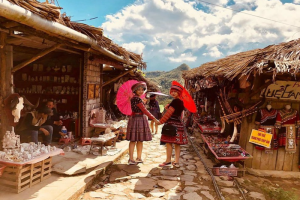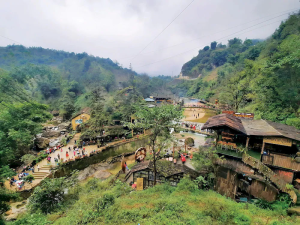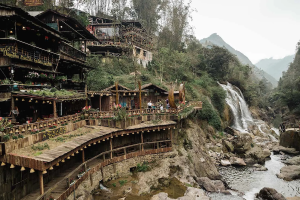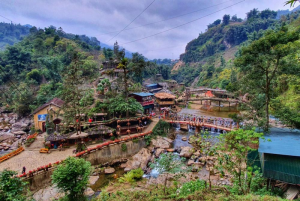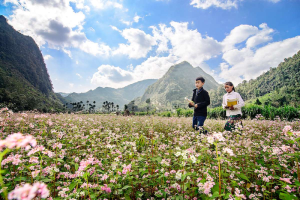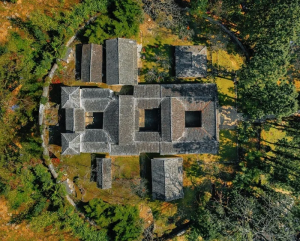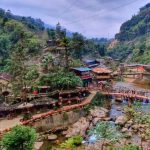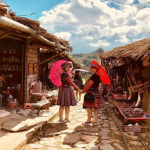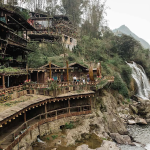Nestled in the heart of Hanoi, Quan Su Pagoda forms an oasis of serenity on the hustling and bustling roads of the city. This draws tourists who would like to have an insight into Vietnamese culture and Buddhist traditions. With its rich history and intriguing features in its architecture, it outstands all other pagodas within the city.
Where is Quan Su Pagoda and What Time Does It Open?

Situated in the busy capital city of Hanoi, Quan Su Pagoda is a quiet oasis from the hustle and bustle of the city. The address to this historic temple is 73 Quan Su Street, Hoan Kiem District, and it is very conveniently located just a hop, skip, and a jump away from Hoan Kiem Lake.
How to Get There:
- By car: From the center of Hanoi, follow Le Thai To Street to the Ba Trieu intersection and turn right. Continue straight until you reach Quan Su Street.
- Public transportation: Many bus lines are running from Quan Su Pagoda, including 01, 32, and 40.
Hours of Operation:
The opening time of Quan Su Pagoda is every day from 6:00 am to 7:00 pm, and during public holidays or special days, the temple can prolong the hour.
Who is Quan Su Pagoda Worshiping? History of Quan Su Pagoda in Hanoi
Quan Su Pagoda represents a place of spiritual retreat, where Buddhist deities are worshipped. In the halls, statues, and shrines of the following entities will be found:
- Bodhisattvas: They were considered as enlightened beings since they express much compassion and wisdom. Statues of major bodhisattvas that exist in Quan Su Pagoda include Avalokiteshvara (Quan Âm), Mañjuśrī (Văn Thù).
- Buddhas: Whereas the pagoda is dedicated to the historical Buddha, Shakyamuni, it is also dedicated to other Buddhas such as Amitabha, known as A Di Đà.
- National Teachers: The temple also honors notable Buddhist teachers, known as national teachers, who have made significant contributions to the development of Vietnamese Buddhism.
The particular arrangement of statues and shrines within the pagoda reflects the complex history of Vietnamese Buddhism and the diverse beliefs of its followers.

A Brief History: Quan Su Pagoda and Its Emergence
Quan Su Pagoda was built during the Tran Dynasty in the 14th century, which pretty much says that this pagoda has a rich and storied past. The pagoda was constructed for the representatives of Buddhism who visited Vietnam from other countries. Soon, Quan Su Pagoda became a hub of religious and cultural activity.
- A Royal Patronage: This pagoda was built on the order of King Tran Du Tong, indicative of the interest in royal patronage given to Buddhism in those times.
- A Congregation of Believers: For many centuries, Quan Su Pagoda would remain a frequent meeting point for the Buddhist clergy and faithful laity. The serenity of its environment and the sacredness of its ambiance remained dominant, though turmoil marked the city.
- A Symbol of National Unity: It has also been a symbol of national unity because it concentrated most of the Vietnamese Buddhists into one single organization, the Vietnam Buddhist Sangha, and led millions of people through spiritual paths. Quan Su Pagoda played an important role in the development of Vietnamese Buddhism in the 20th century.
- A Living Tradition: Centuries have gone by; many renovations have been made, and yet Quan Su Pagoda lives to this day as a spiritual hub. Traditional architecture with intricate carvings and the overall serenity of the ambiance afford visitors a glimpse of Vietnam’s Buddhist heritage.

Today, Quan Su Pagoda is a witness to the enduring power of faith and a reminder of how important it is to preserve cultural heritage. This pagoda provides the perfect atmosphere in tranquil surroundings and a rich history that needs to be etched into the minds of travelers coming for enlightenment regarding Vietnamese culture.
Key Points to Keep in Mind
- Quan Su Pagoda is a multi-dimensional religious site honoring several Buddhist deities.
- The pagoda has a history dating back to the 14th century, glorious and long.
- It first played an important role in the formation of Vietnamese Buddhism and still acts as the spiritual home for millions.
- The architecture and artifacts of the pagoda reflect the various influences on Vietnamese Buddhism.
Thus, by explaining the history and significance of Quan Su Pagoda, this paper carefully researched by Lily’s Travel can provide a deeper appreciation for such a holy place and its people who have worshipped there for many centuries.
4 Special Things About Quan Su Pagoda That Not Everyone Knows
Quan Su Pagoda is a place of rich cultural and historical significance; a visit to this site will definitely provide one with an experience that might just prove to be enriching. Besides the beautiful architecture and deep-rooted history, this ancient temple has several characteristic features that make it pretty different from any other pagoda across Vietnam.
1. Quan Su Pagoda’s Architecture Is Imbued With The Ancient Style Of The North
Quan Su Pagoda represents very well traditional architecture from North Vietnam. It harmoniously combines the style, elegance, and simplicity of some of the most famous temples in the region.
- Symbolical Setting: The pagoda structure is symbolic, with the inner courtyard resembling the Chinese character for “work” (Công) and the outer courtyard representing the Chinese character for “country” (Quốc), reflecting their relationship in harmony with each other.
- Structures: The many structures that make up the pagoda include a three-story bell tower, a main sanctuary, and surrounding halls. The intricate woodwork is adorned with ornate carvings.

2. Quan Su Pagoda Does Not Worship The Mother Goddess Of The Three Palaces
While most of the other pagodas of Vietnam also enshrine folk beliefs, the Quan Su Pagoda is strictly dedicated to Buddhist principles. It was the place for worshiping Buddha and Bodhisattvas and other monks who earned respect.
- A Pantheon of Deities: The pagoda is home to several statues of various Buddhist gods, including the Buddha, Avalokiteshvara (Quan Âm), and Mañjuśrī (Văn Thù).
- No worship of folk deities: Unlike other temples in the country, shrines dedicated to the cult of folk deities, such as the Mother Goddess of the Three Palaces, are absent from Quan Su Pagoda.

3. It Is The Central Headquarters Of The Vietnam Buddhist Sangha
Quan Su Pagoda has a special position in the hearts of Vietnamese Buddhists. In its capacity as the central headquarters of the Vietnam Buddhist Sangha, Quan Su Pagoda is one of the pivotal points of religious activities and cultural events.
- A Center of Learning: Other than the library, lecture hall, and research institute, the pagoda also provides a home for Buddhist studies and scholarship.
- A Place of Unity: Quan Su Pagoda has played an instrumental role in the unification of Vietnamese Buddhists and the promotion of interfaith dialogue.

Read more: The Legend of Bach Ma Temple: Hanoi’s Guardian Spirit
4. The Writings And Parallel Sentences In The Pagoda Are All Written In Quoc Ngu
One of the distinctive features of Quan Su Pagoda is that all inscriptions and writings use the Vietnamese national script called Quoc Ngu.
- A Modern Touch: Whereas many of the older temples in Vietnam made use of Chinese characters in one form or another, Quan Su Pagoda stands apart by embracing a more modern and accessible form of communication.
- Improvement in Literacy: Quoc Ngu has made Buddhism more accessible to the general people; especially to those people who did not possess good literacy in Chinese.
These features make Quan Su Pagoda a unique place. Whether you are a Buddhist adherent or an inquisitive traveler, this will be your memorable visit to the historic temple.

Notes When Visiting Quan Su Pagoda
Here are some tips for a respectful, peaceful visit to Quan Su Pagoda:
- Wear decent attire: Neither too showy nor casual. If possible, wear clothes to cover up your shoulders and knees.
- Minimize any unnecessary noise to add to the serenity. Avoid loud conversations by turning down to whispered tones, especially in prayer areas.
- Respect the Holy Place: Without permission, do not touch anything and/or move anything in the temple. Be respectful towards the pagoda and the things kept inside.
- Photography: Photography in general is allowed, but please pay respect to other visitors by not using flash. It is recommended to ask for permission before taking photos in certain areas.
- Offerings: In case you would want to do an offering, please follow the guidance from the temple.
- Schedule Your Visit: When possible, avoid crowds by visiting the pagoda on a weekday or when it is less busy.
- Special Occasions: Be aware of special events and holidays that may attract large crowds, such as the Lunar New Year, Buddha’s Birthday, and Ullambana (Vu Lan).
- Participate in the Rituals: If you are interested in learning more about Buddhist practices, you may join in the various rituals and ceremonies that take place at the pagoda.

Read more: Hanoi’s Quan Thanh Temple: A Timeless Legacy
Tourist Attractions Near Quan Su Pagoda
Right after getting soaked in the spiritual atmosphere of Quan Su Pagoda, head out on a voyage of some major iconic landmarks of Hanoi. These are located fairly nearby from the pagoda, so it is very easy to schedule them for your trip. To avoid such unnecessary problems, consider booking a Lily’s Travel tour as we will include all the attractions based on your interest.
- Prison Hoa Lo: No more than a few minutes walk from the previous place, the Hoa Lo Prison offers a grim look into Vietnam’s French colonial history. This former French colonial prison was used to house Vietnamese political prisoners, including Ho Chi Minh.

- Thang Long Imperial Citadel: The following is the UNESCO World Heritage Site of Thang Long Imperial Citadel, a complex of structures that date back centuries and serve as the political center of Vietnam. Explore the excavated remains of palaces, temples, and fortifications.
- Ho Chi Minh Mausoleum: Pay your respects at the final resting place of Vietnam’s beloved leader, Ho Chi Minh. Visitors can view the preserved body of Ho Chi Minh and learn more about his life and legacy.
- Hoan Kiem Lake: Take a leisurely walk around Hoan Kiem Lake, also as the Lake of the Returned Sword. This beautiful lake is a favorite among locals and visitors alike.

Quan Su Pagoda is the spiritual sanctuary set amidst bustling Hanoi and weaves an enviable tapestry of timeless history, rich cultural heritage, and tranquility. From its intricately etched architecture to deeply set traditions of Buddhism, this ancient temple simply continues to fascinate visitors from all walks of life. Whether you are a devout Buddhist or simply seeking a peaceful retreat, Quan Su Pagoda is a must-visit destination.
To plan your visit to Quan Su Pagoda and other attractions in Hanoi, consider the expertise of Lily’s Travel. As a renowned travel agency, Lily’s Travel can provide personalized itineraries, accommodation arrangements, and expert guidance to ensure a seamless and unforgettable experience.





